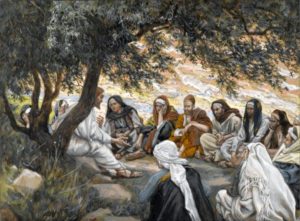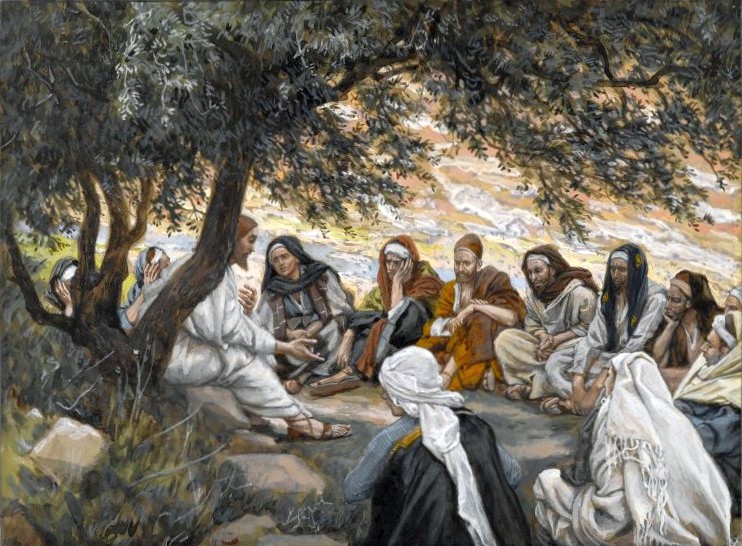 I’d like to return to a brief Gospel that was read last week at daily Mass (Friday of the 24th Week of the Year). Though terse to the point of leaving a preacher wondering what to say, it actually paints a beautiful picture of the Church. Here is that short passage, followed by some commentary.
I’d like to return to a brief Gospel that was read last week at daily Mass (Friday of the 24th Week of the Year). Though terse to the point of leaving a preacher wondering what to say, it actually paints a beautiful picture of the Church. Here is that short passage, followed by some commentary.
And it came to pass that Jesus journeyed throughout the towns and villages,
preaching and proclaiming the good news of the Kingdom of God.
Accompanying him were the Twelve
and some women who had been cured of evil spirits and infirmities,
Mary, called Magdalene, from whom seven demons had gone out,
Joanna, the wife of Herod’s steward Chuza,
Susanna, and many others
who provided for them out of their resources (Luke 8:1-3).
Let’s look at the picture of the Church presented here:
I. They are with Jesus.
Though small, the community consists of head and members together. Jesus, the Head of the Body (the Church), is journeying, and His members are with Him. They are men and women, clergy (Apostles) and lay.
They are with Jesus and Jesus is with them. Some today think they can have Jesus without the Church. Sorry, no can do. Jesus is far more than just your personal Lord and savior. Head and members are together. The text says that they accompany Jesus, but they do not do this as isolated individuals. Jesus does not make a merely personal journey with them, but a communal one as well.
Each does his part and depends on the others.
This is another way of describing the Church as “one” and refers to one of the four marks of the Church mentioned in the early creeds: one, holy, catholic, and apostolic. Christ has one Body, the Church. He does not have many bodies, nor is Christ dismembered; the parts of His body are not scattered about and separated.
According to Ephesians 5 and Revelation 20-25, the Church is also Bride. Christ does not have many brides; he is no polygamist. He has one bride, the Church. Yes, the Church is “one.”
II. They are journeying throughout the area from one town to another.
This is another way of describing the Church with another of the four marks of the Church. The Church is “catholic” (universal). The Church goes everywhere, throughout the known regions, throughout the world. The Church calls everyone to faith, repentance, and salvation.
III. They are proclaiming the Kingdom of God.
The Greek text uses two terms to describe their fundamental work: κηρύσσων καὶ εὐαγγελιζόμενος (kerusson kai euaggelizomenos).
Kērýssō means to herald, to announce a message publicly and with conviction in order to persuade.
Euaggelizō comes from eu (well) and angellō (to proclaim). This same word was used to describe proclamations by the Roman emperors; and their messages most certainly would change the lives of those who heard them. How much more so the true evanggelion (gospel)!
Thus, they were proclaiming well a lifesaving and transformative message. The early Church went about heralding, like a town crier, the truth of the Gospel with conviction. They proclaimed the lifesaving transformative message of the true God.
So, too, today—if we truly are the Church we claim to be. Note that this message was proclaimed with Christ and the Apostles. There is no true proclamation of the Gospel apart from union with Christ, the source, and His appointed witnesses, the Apostles. This points to another of the four marks of the Church: apostolic.
IV. They are changed by their encounter, healed, and drawn to greater holiness.
Here is another of the four marks of the Church: holy. The Church is holy by the grace of Christ. Despite including sinners in her midst, she is granted by Christ the means of holiness through grace, the sacraments, the Word of God, and prayer.
The normal Christian life consists of being healed and made more holy. All the members described in this passage have had their lives changed; they were healed and made more holy. Some have had demons driven out, others have been called from lesser to higher things (e.g., Luke 5:10). All have been moved and astonished by the Lord’s teachings and are now following Him generously, giving Him their time and resources—their very selves. They are seeing their lives changed, their minds enlightened, and their wills strengthened. They are not perfect or complete, but they are on the way with Jesus. They have taken him into the boat of their lives.
V. They are organized.
Note, finally, that there is an organization in this picture of the early Church. Too easily we imagine that Jesus and the Twelve just walked about aimlessly, going from one town to the next as seemed expedient. No, not so. Jesus had things planned out. He knew each town He planned to visit and sent delegations of disciples ahead to prepare the people (e.g., Luke 10:1).
Further, the early Church depended on the donations of the women and others described in this passage, who helped them out of their means. Others were involved in preparing meals, arranging for lodging, etc. We know that Judas was the treasurer, so there must have been funds that needed to be managed (see John 12:6).
Surely there were many logistical concerns for this small but not insignificant band of early Christians, who provide an image of the Church in her infancy. Even today practical concerns are not absent. There are monies needed, provisions to be procured, plans to be implemented, and repairs to be made to structures and people.
From just a few almost terse lines comes a rich description of the early Church, the infant Church. It is also an exhortation for all of us, who can benefit from this pure picture of the Church as one, holy, Catholic, apostolic, and organized!

